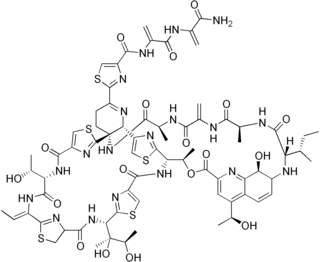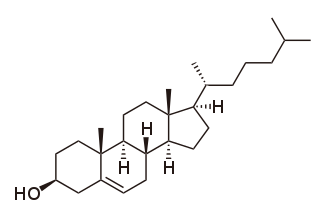
Lovastatin, sold under the brand name Mevacor among others, is a statin medication, to treat high blood cholesterol and reduce the risk of cardiovascular disease. Its use is recommended together with lifestyle changes. It is taken by mouth.
Okadaic acid, C44H68O13, is a toxin produced by several species of dinoflagellates, and is known to accumulate in both marine sponges and shellfish. One of the primary causes of diarrhetic shellfish poisoning, okadaic acid is a potent inhibitor of specific protein phosphatases and is known to have a variety of negative effects on cells. A polyketide, polyether derivative of a C38 fatty acid, okadaic acid and other members of its family have shined light upon many biological processes both with respect to dinoflagellete polyketide synthesis as well as the role of protein phosphatases in cell growth.
Phytotoxins are substances that are poisonous or toxic to the growth of plants. Phytotoxic substances may result from human activity, as with herbicides, or they may be produced by plants, by microorganisms, or by naturally occurring chemical reactions.

Neocamarosporium betae is a plant pathogen infecting Beta vulgaris (beet) and causes Phoma leaf spot. It was originally published and described in 1877 as Pleospora betae before being resolved as Neocamarosporium betae(Berl.) Ariyaw. & K.D. Hyde in 2015. It also causes leaf spot on Spinach plants.

Thiostrepton is a natural cyclic oligopeptide antibiotic of the thiopeptide class, derived from several strains of streptomycetes, such as Streptomyces azureus and Streptomyces laurentii. Thiostrepton is a natural product of the ribosomally synthesized and post-translationally modified peptide (RiPP) class.
The vinylcyclopropane rearrangement or vinylcyclopropane-cyclopentene rearrangement is a ring expansion reaction, converting a vinyl-substituted cyclopropane ring into a cyclopentene ring.

Sparsomycin is a compound, initially discovered as a metabolite of the bacterium Streptomyces sparsogenes, which binds to the 50S ribosomal subunit and inhibits protein synthesis through peptidyl transferase inhibition. As it binds to the 50S ribosomal subunit, it induces translocation on the 30S subunit. It is a nucleotide analogue. It was also formerly thought to be a possible anti-tumor agent, but interest in this drug was later discarded after it was discovered that it resulted in retinopathy and as a tool to study protein synthesis; it is not specific for bacterial ribosomes and so not usable as an antibiotic.

Carpanone is a naturally occurring lignan-type natural product most widely known for the remarkably complex way nature prepares it, and the similarly remarkable success that an early chemistry group, that of Orville L. Chapman, had at mimicking nature's pathway. Carpanone is an organic compound first isolated from the carpano trees of Bougainville Island by Brophy and coworkers, trees from which the natural product derives its name. The hexacyclic lignan is one of a class of related diastereomers isolated from carpano bark as mixtures of equal proportion of the "handedness" of its components, and is notable in its stereochemical complexity, because it contains five contiguous stereogenic centers. The route by which this complex structure is achieved through biosynthesis involves a series of reactions that, almost instantly, take a molecule with little three-dimensionality to the complex final structure. Notably, Brophy and coworkers isolated the simpler carpacin, a phenylpropanoid with a 9-carbon framework, recognized its substructure as being dimerized within the complex carpanone structure, and proposed a hypothesis of how carpacin was converted to carpanone in plant cells:

Nargenicin is a 28 carbon macrolide with a fused tricyclic core that has in addition a unique ether bridge. The polyketide antibiotic was isolated from Nocardia argentinensis. Nargenicin is effective towards gram-positive bacteria and been shown to have strong antibacterial activity against Staphylococcus aureus, including strains that are resistant to methicillin. It has also been shown to induce cell differentiation and inhibit cell proliferation in a human myeloid leukemia cell line.

Absinthin is a naturally produced triterpene lactone from the plant Artemisia absinthium (Wormwood). It constitutes one of the most bitter chemical agents responsible for absinthe's distinct taste. The compound shows biological activity and has shown promise as an anti-inflammatory agent, and should not be confused with thujone, a neurotoxin also found in Artemisia absinthium.

Endiandric acid C, isolated from the tree Endiandra introrsa, is a well characterized chemical compound. Endiadric acid C is reported to have better antibiotic activity than ampicillin.

Torreyanic acid is a dimeric quinone first isolated and by Lee et al. in 1996 from an endophyte, Pestalotiopsis microspora. This endophyte is likely the cause of the decline of Florida torreya, an endangered species that is related to the taxol-producing Taxus brevifolia. The natural product was found to be cytotoxic against 25 different human cancer cell lines with an average IC50 value of 9.4 µg/mL, ranging from 3.5 (NEC) to 45 (A549) µg/mL. Torreyanic acid was found to be 5-10 times more potent in cell lines sensitive to protein kinase C (PKC) agonists, 12-o-tetradecanoyl phorbol-13-acetate (TPA), and was shown to cause cell death via apoptosis. Torreyanic acid also promoted G1 arrest of G0 synchronized cells at 1-5 µg/mL levels, depending on the cell line. It has been proposed that the eukaryotic translation initiation factor EIF-4a is a potential biochemical target for the natural compound.

Cholesterol total synthesis in chemistry describes the total synthesis of the complex biomolecule cholesterol and is considered a great scientific achievement. The research group of Robert Robinson with John Cornforth published their synthesis in 1951 and that of Robert Burns Woodward with Franz Sondheimer in 1952. Both groups competed for the first publication since 1950 with Robinson having started in 1932 and Woodward in 1949. According to historian Greg Mulheirn the Robinson effort was hampered by his micromanagement style of leadership and the Woodward effort was greatly facilitated by his good relationships with chemical industry. Around 1949 steroids like cortisone were produced from natural resources but expensive. Chemical companies Merck & Co. and Monsanto saw commercial opportunities for steroid synthesis and not only funded Woodward but also provided him with large quantities of certain chemical intermediates from pilot plants. Hard work also helped the Woodward effort: one of the intermediate compounds was named Christmasterone as it was synthesized on Christmas Day 1950 by Sondheimer.

Betaenone A, like other betaenones, is a secondary metabolite isolated from the fungus Pleospora betae, a plant pathogen. Of the seven phytotoxins isolated in fungal leaf spots from sugar beet, it showed 73% growth inhibition.

Betaenone C, like other betaenones, is a secondary metabolite isolated from the fungus Pleospora betae, a plant pathogen. Of the seven phytotoxins isolated in fungal leaf spots from sugar beet, it showed 89% growth inhibition. Betaenone C has been shown to act by inhibiting RNA and protein synthesis.

Betaenones are phytotoxins found in the fungus Pleospora betae. The compounds were found to inhibit a variety of protein kinases.

Rubicordifolin is a natural product that is produced by Rubia cordifolia, a plant of the family Rubiaceae. The molecule is isolated from the roots of Rubia cordifolia and was first characterized in 1993. In 2004, the first synthesis of rubicordifolin was accomplished. The molecule has been shown to have cytotoxic properties in vitro.
Prosolanapyrone-II oxidase (EC 1.1.3.42, Sol5, SPS, solanapyrone synthase (bifunctional enzyme: prosolanapyrone II oxidase/prosolanapyrone III cycloisomerase), prosolanapyrone II oxidase) is an enzyme with systematic name prosolanapyrone-II:oxygen 3'-oxidoreductase. This enzyme catalyses the following chemical reaction
Prosolanapyrone-III cycloisomerase is an enzyme with systematic name prosolanapyrone-III:(-)-solanapyrone A isomerase. This enzyme catalyses the following chemical reaction

Fluoromedroxyprogesterone acetate is a synthetic steroid medication which was under development by Meiji Dairies Corporation in the 1990s and 2000s for the potential treatment of cancers but was never marketed. It is described as an antiangiogenic agent, with about two orders of magnitude greater potency for inhibition of angiogenesis than its parent compound medroxyprogesterone acetate. FMPA showed about the same affinities for the progesterone and glucocorticoid receptors as MPA. It reached the preclinical phase of research prior to the discontinuation of its development.

















